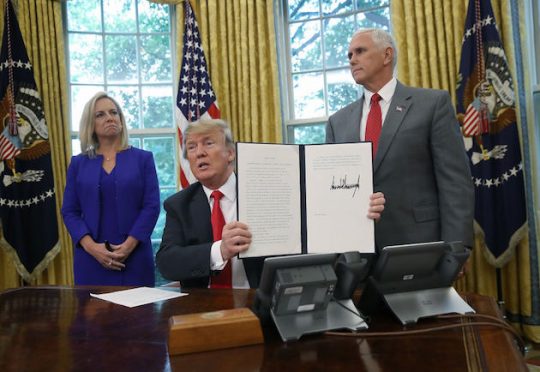President Donald Trump signed an executive order Wednesday afternoon to address the ongoing controversy surrounding the separation of parents and children detained at the border, ordering the Department of Homeland Security to keep families together for the duration of their immigration processing.
Trump's order was prompted by the backlash sparked by policies leading to the separation of children and parents detained at the border, with as many as 2,000 children separated from their parents. The controversy had already prompted multiple legislative fixes when Trump signed the executive order himself.
It is unlikely that the EO will end the controversy. That's because it's likely to run up against a preexisting federal ruling: a fight that, Trump signals in the EO, this administration is raring to have.
After a sharp drop during year one of the Trump administration, rates of illegal entry at the southwestern border have risen back to pre-Trump rates in 2018. Attorney General Jeff Sessions in April announced the implementation of a "zero tolerance" policy along the southwestern border, meaning that any person crossing the border not at an appropriately designated time and place would be charged with violating federal law. There was a concurrent spike in prosecutions.
Many of those people crossed the border as a family: about a quarter of those apprehended by the Border Patrol, and about 40 percent of those apprehended at designated ports of entry entering illegally. Before the zero tolerance regime, these families would be detained temporarily or released into the interior; many subsequently skipped out on their mandated immigration court hearings.
Zero tolerance aims to resolve this de facto free immigration by charging illegal crossers, meaning that they need to be detained for court proceedings (which usually end with a sentence of time served plus deportation). This is where the family separation comes in. When an adult border crosser is charged with a crime, he or she is remanded by DHS to the Justice Department, in the custody of the U.S. Marshall Service.
However, kids don't get sent to jail. Once the parent has been handed off to USMS, DHS designates their children as "unaccompanied minors," and remands them to the custody of the Department of Health and Human Services. HHS places them in a shelter or with a family member or other responsible adult in the interior under the auspices of the Office of Refugee Resettlement (these are the missing children you may have heard about: they are placed with family members, then fail to answer subsequent inquiries from HHS, often to avoid deportation).
The Trump EO resolves this situation, in Sec. 3(a), by mandating that the Department of Homeland Security shall "maintain custody of alien families during the pendency of any criminal improper entry or immigration proceedings involving their members." Parents and children are no longer separated, because they remain DHS's responsibility.
Problem solved, right? Not quite.
That's because of something called the Flores settlement, a 1997 agreement between the federal government and a group of unaccompanied minors on whose behalf litigators had been fighting since the 1980s. Flores stipulates that "juveniles be released from custody without unnecessary delay," which judges have concluded means a 20-day maximum on detention of minors. Flores also says that until minors are released, they must be held in the "least restrictive setting appropriate to age and special needs."
The Trump administration zero tolerance policy, combined with the proliferation of often-phony asylum claims, means that most border crossers' cases will not be processed within the 20-day window set up by Flores. This is why the administration was separating children: because it knew that if it didn't, it wouldn't be able to detain parents beyond 20 days for purposes of prosecution.
The Trump executive order acknowledges this, calling for the prioritizing of adjudicating cases involving detained families. More importantly, it instructs the Attorney General to file a request with the U.S. District Court in central California—where Flores was settled—to modify the agreement so that DHS can hold families together beyond the 20-day window.
This will almost certainly prompt a legal fight, but it's likely that the administration wants exactly that. Getting rid of Flores is on the laundry list of reforms that administration officials have said are needed to close immigration loopholes, alongside reforming the asylum process and changing the 2008 Trafficking Victims Protection Reauthorization act so that illegal immigrants from central America can be more swiftly deported.
So, what's next? Firstly, a court battle over Flores and the alterations that Trump is seeking to it. Secondly, Congress may act to legislatively mandate that the executive branch can keep families together, with or without a fix to Flores and other loopholes. However, if Senate Minority Leader Chuck Schumer's actions (D., N.Y.) are anything to go by, Democrats don't see a fix as in their interest, especially with an impending midterm election.
It's not clear how all this will play in the electorate. Family separation is very unpopular, according to an Economist/YouGov poll, but a plurality of people support actually enforcing immigration law with the zero-tolerance approach. And only 19 percent of Americans reported releasing families into the interior wholesale, the approach that Democrats are likely to advocate for over detention in DHS facilities.
